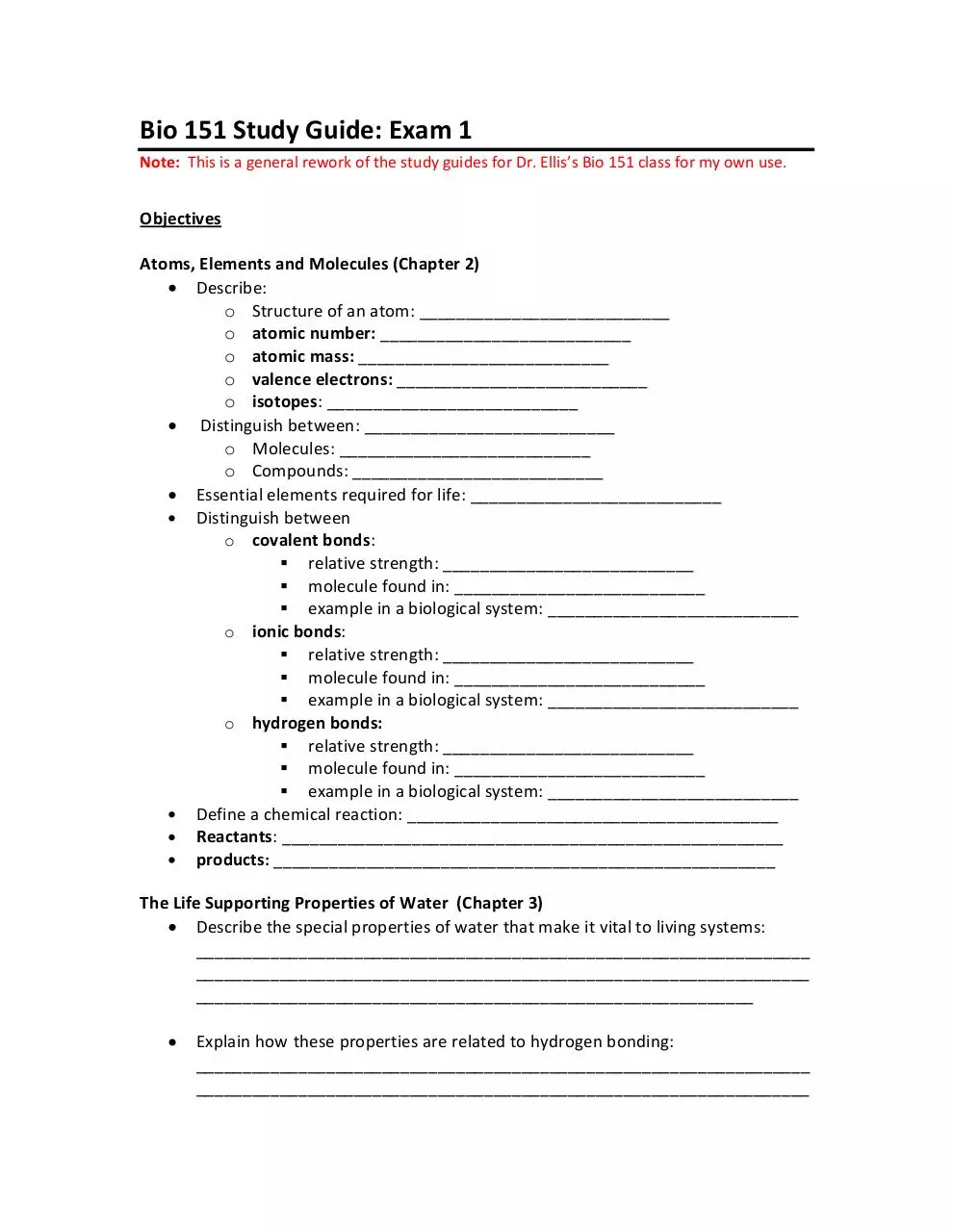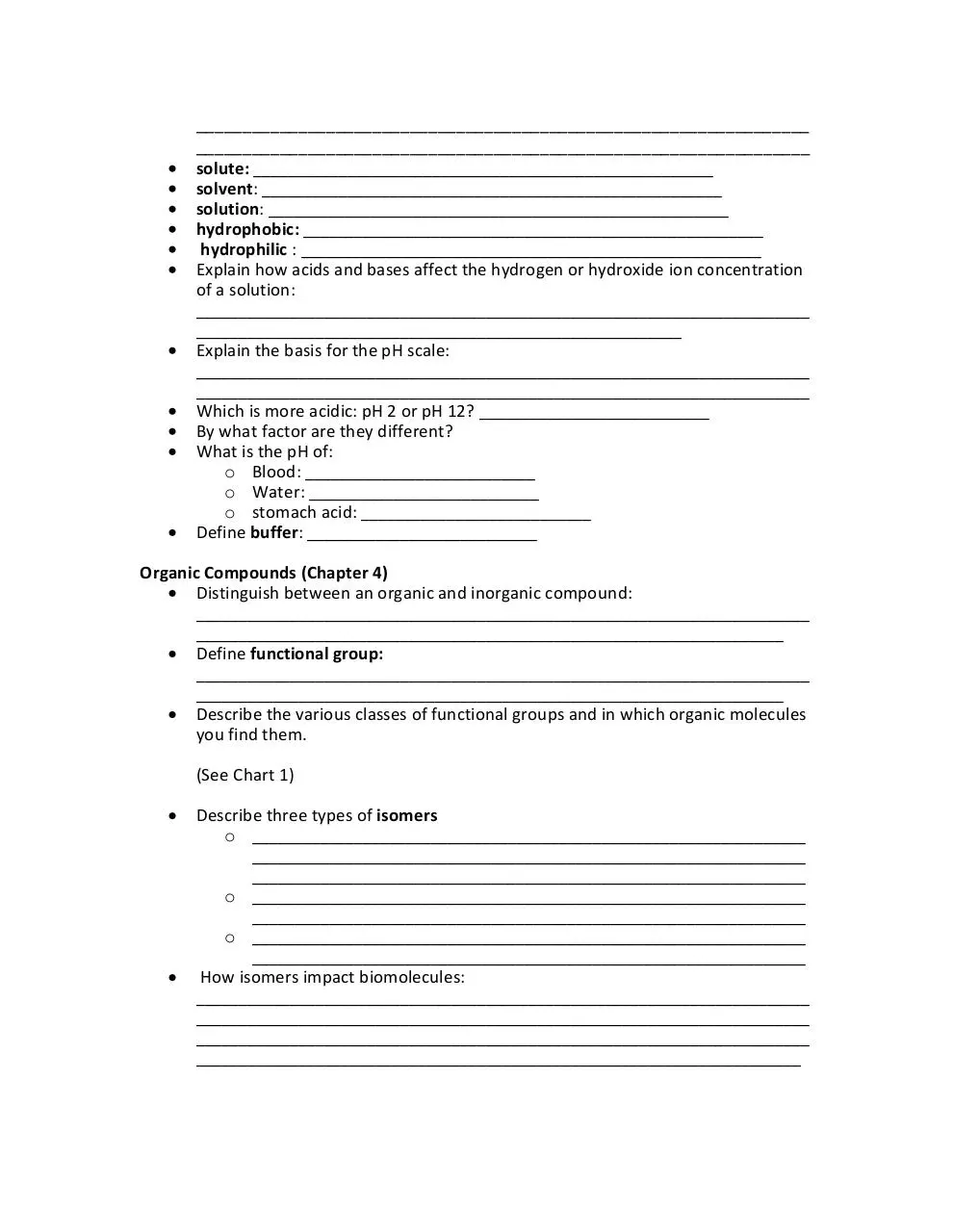bio exam 1 (PDF)
File information
Author: Sarah Wojiski
This PDF 1.5 document has been generated by Microsoft® Office Word 2007, and has been sent on pdf-archive.com on 01/10/2016 at 21:05, from IP address 73.186.x.x.
The current document download page has been viewed 1127 times.
File size: 433.05 KB (11 pages).
Privacy: public file





File preview
Bio 151 Study Guide: Exam 1
Note: This is a general rework of the study guides for Dr. Ellis’s Bio 151 class for my own use.
Objectives
Atoms, Elements and Molecules (Chapter 2)
Describe:
o Structure of an atom: ___________________________
o atomic number: ___________________________
o atomic mass: ___________________________
o valence electrons: ___________________________
o isotopes: ___________________________
Distinguish between: ___________________________
o Molecules: ___________________________
o Compounds: ___________________________
Essential elements required for life: ___________________________
Distinguish between
o covalent bonds:
relative strength: ___________________________
molecule found in: ___________________________
example in a biological system: ___________________________
o ionic bonds:
relative strength: ___________________________
molecule found in: ___________________________
example in a biological system: ___________________________
o hydrogen bonds:
relative strength: ___________________________
molecule found in: ___________________________
example in a biological system: ___________________________
Define a chemical reaction: ________________________________________
Reactants: ______________________________________________________
products: ______________________________________________________
The Life Supporting Properties of Water (Chapter 3)
Describe the special properties of water that make it vital to living systems:
__________________________________________________________________
__________________________________________________________________
____________________________________________________________
Explain how these properties are related to hydrogen bonding:
__________________________________________________________________
__________________________________________________________________
__________________________________________________________________
__________________________________________________________________
solute: ______________________________________________________
solvent: ______________________________________________________
solution: ______________________________________________________
hydrophobic: ______________________________________________________
hydrophilic : ______________________________________________________
Explain how acids and bases affect the hydrogen or hydroxide ion concentration
of a solution:
________________________________________________________________________
_________________________________________________________
Explain the basis for the pH scale:
________________________________________________________________________
________________________________________________________________________
Which is more acidic: pH 2 or pH 12? ___________________________
By what factor are they different?
What is the pH of:
o Blood: ___________________________
o Water: ___________________________
o stomach acid: ___________________________
Define buffer: ___________________________
Organic Compounds (Chapter 4)
Distinguish between an organic and inorganic compound:
________________________________________________________________________
_____________________________________________________________________
Define functional group:
________________________________________________________________________
_____________________________________________________________________
Describe the various classes of functional groups and in which organic molecules
you find them.
(See Chart 1)
Describe three types of isomers
o _________________________________________________________________
_________________________________________________________________
_________________________________________________________________
o _________________________________________________________________
_________________________________________________________________
o _________________________________________________________________
_________________________________________________________________
How isomers impact biomolecules:
________________________________________________________________________
________________________________________________________________________
________________________________________________________________________
_______________________________________________________________________
Biological Macromolecules (Chapter 5)
Monomers: ___________________________
Polymers: ___________________________
Dehydration synthesis:
________________________________________________________________________
________________________________________________________________________
_____________
o describe how it helps to form macromolecules: _____________________
_________________________________________________________________
_________________________________________________________________
_______________________________________________________________
o how it helps to degrade macromolecules:
_________________________________________________________________
_________________________________________________________________
_________________________________________________________________
_________________________________________________________________
_____________________
Hydrolysis:
________________________________________________________________________
__________________________________________________________
o describe how it helps to form macromolecules: _____________________
_______________________________________________________________
o how it helps to degrade macromolecules: _____________________
_______________________________________________________________
Describe the four classes of macromolecules:
o 1) _______________________________
Monomers its composed of: ______________________________
Examples of macromolecule: ____________________________
Celular Function: ____________________________
o 2) _______________________________
Monomers its composed of: ______________________________
Examples of macromolecule: ____________________________
Celular Function: ____________________________
o 3) _______________________________
Monomers its composed of: ______________________________
Examples of macromolecule: ____________________________
Celular Function: ____________________________
o 4) _______________________________
Monomers its composed of: ______________________________
Examples of macromolecule: ____________________________
Celular Function: ____________________________
Glucose
o Structure: _______________________________
o Function: _______________________________
Starch
o Structure: _______________________________
o Function: _______________________________
Glycogen
o Structure: _______________________________
o Function: _______________________________
Cellulose
o Structure: _______________________________
o Function: _______________________________
Saturated fats: _______________________________
unsaturated and trans fats: _______________________________
hydrogenation: _______________________________
o How does it affect the structure of a fat?:
___________________________________________________________
_________________________________________________________________
_________________________________________________________________
o how this relates to human health:
___________________________________________________________ _
_________________________________________________________________
________________________________________________________________
Describe the four levels of protein structure
o 1) _______________________________
o 2) _______________________________
o 3) _______________________________
o 4) _______________________________
chaperonins contribute to protein structure:
__________________________________________________________________
________________________________________________________________________
______________________________________________________
Compare and contrast the structures and functions of DNA and RNA:
__________________________________________________________________
________________________________________________________________________
______________________________________________________
Describe the significance of hydrogen bonding in the structure of DNA:
__________________________________________________________________
________________________________________________________________________
______________________________________________________
Microscopy (Chapter 6)
light microscope: ____________________________________________
o When would you use this: _____________________________
scanning electron microscope: ______________________________________
o When would you use this: ___________________________________
transmission electron microscope: ___________________________________
o When would you use this: ___________________________________
Magnification: ___________________________________
Resolution: ___________________________________
Contrast: ___________________________________
Introduction to Cells and Viruses (Chapter 6 and Chapter 19.1)
Prokaryotic cells: ___________________________________
o Main internal structures: ___________________________________
o Main external structures: ___________________________________
Eukaryotic cells: ___________________________________
o Main internal structures: ___________________________________
o Main external structures: ___________________________________
Describe what bacterial structures help them to cause infections in humans:
_____________________________________________________________
Compare the structures of plant and animal cells:
__________________________________________________________________
Describe the structure of a virus: ___________________________________
Capsid: ___________________________________
Envelope: ___________________________________
Eukaryotic Organelles (Chapter 6)
Nucleus: ___________________________________
o Structure: ___________________________________
o Function: ___________________________________
Endomembrane system: ___________________________________
o Structure: ___________________________________
o Function: ___________________________________
Smooth endoplasmic reticulum: ___________________________________
o Structure: ___________________________________
o Function: ___________________________________
Smooth endoplasmic reticulum: ___________________________________
o Structure: ___________________________________
o Function: ___________________________________
Golgi apparatus: ___________________________________
o Structure: ___________________________________
o Function: ___________________________________
Ribosomes: ___________________________________
o Structure: ___________________________________
o Function: ___________________________________
Lysosomes: ___________________________________
o Structure: ___________________________________
o Function: ___________________________________
Peroxisomes: ___________________________________
o Structure: ___________________________________
o Function: ___________________________________
Describe the route of an exported protein from its production to its exit from the
cell:
______________________________________________________________________
Mitochondria: ___________________________________
o Structure: ___________________________________
o Function: ___________________________________
Chloroplast: ___________________________________
o Structure: ___________________________________
o Function: ___________________________________
The Cytoskeleton and Related Structures (Chapter 6)
Microtubules
o Structure: ___________________________________
o Function: ___________________________________
intermediate filaments
o Structure: ___________________________________
o Function: ___________________________________
Microfilaments
o Structure: ___________________________________
o Function: ___________________________________
Actin: ___________________________________
myosin: ___________________________________
dynein: ___________________________________
tubulin: ___________________________________
Centrioles
o Structure: ___________________________________
o Function: ___________________________________
Cilia
o Structure: ___________________________________
o Function: ___________________________________
Flagella
o Structure: ___________________________________
o Function: ___________________________________
Describe the three different types of cell junctions found in animal cells.
o 1) ___________________________________
o 2) ___________________________________
o 3) ___________________________________
Describe the role of the extracellular matrix in regulating cell behavior and cellcell communication.
__________________________________________________________________
________________________________________________________________
__________________________________________________________________
***Complete the Following Chart***
Organelle
Nucleus
Nucleolus
Nuclear Pore
Ribosome
Mitochondria
Nuclear envelope
Plasma Membrane
Lysosome
Rough Edoplasmic
Reticulum
Smooth
Endoplasmic
Reticulum
Golgi Apparatus
Cilia
Flagella
Chloroplast
Microtubules
Intermediate
Filaments
Microfilaments
Centrosomes
Peroxisome
Location
Function(s)
Membrane Structure (Chapter 7)
Phospholipids: ___________________________________
Cholesterol: ___________________________________
integral proteins: ___________________________________
peripheral proteins: ___________________________________
glycolipids: ___________________________________
glycoproteins: ___________________________________
Explain the fluid-mosaic model of cell membranes:
_________________________________________________________________
Membrane Function (Chapter 7)
Explain how membranes organize the various chemical activities of a cell:
________________________________________________________________________
________________________________________________________________________
________________________________________________________
Explain why the plasma membrane is selectively permeable:
________________________________________________________________________
________________________________________________________________________
________________________________________________________
Describe the diverse functions of membrane proteins:
________________________________________________________________________
________________________________________________________________________
________________________________________________________
Movement Across Membranes (Chapter 7)
diffusion: ___________________________________
passive transport: ___________________________________
active transport: ___________________________________
pump proteins: ___________________________________
Describe an example of active transport found in most cells:
___________________________________
faciliated diffusion: ___________________________________
osmosis: ___________________________________
hypertonic: ___________________________________
hypotonic: ___________________________________
isotonic: ___________________________________
What happens to animal cells when they are placed in each of these types of
solutions:
exocytosis: ___________________________________
endocytosis: ___________________________________
pinocytosis: ___________________________________
phagocytosis: ___________________________________
receptor-mediated endocytosis: ___________________________________
Energy and the Cell (Chapter 8)
metabolism: ___________________________________
o biological example: ___________________________________
catabolism: ___________________________________
o biological example: ___________________________________
anabolism: ___________________________________
o biological example: ___________________________________
kinetic energy: ___________________________________
thermal energy: ___________________________________
chemical energy: ___________________________________
potential energy: ___________________________________
Describe the circumstances under which a chemical reaction would occur
spontaneously: ___________________________________
Endergonic reaction : ___________________________________
o Energy coupling: ___________________________________
o ATP: ___________________________________
o Flow of energy: ___________________________________
exergonic reactions: ___________________________________
o Energy coupling: ___________________________________
o ATP: ___________________________________
o Flow of energy: ___________________________________
How ATP is both formed and used in reactions:
__________________________________________________________________
__________________________________________________________________
Explain how:
o cells use the hydrolysis of ATP to do work:
____________________________________________________________
____________________________________________________________
_______________________________________________________
o describe examples:
____________________________________________________________
____________________________________________________________
____________________________________________________________
___________________________________________________________
Enzymes (Chapter 8)
Define enzyme: ___________________________________
explain how enzymes speed up chemical reactions:
________________________________________________________________________
________________________________________________________________________
__________________________________________________________________
Describe “activation energy”: ___________________________________
o
how it relates to enzymes:
_________________________________________________________________
_________________________________________________________________
_________________________________________________________________
Define substrate site:
______________________________________________________________________
Download bio exam 1
bio exam 1.pdf (PDF, 433.05 KB)
Download PDF
Share this file on social networks
Link to this page
Permanent link
Use the permanent link to the download page to share your document on Facebook, Twitter, LinkedIn, or directly with a contact by e-Mail, Messenger, Whatsapp, Line..
Short link
Use the short link to share your document on Twitter or by text message (SMS)
HTML Code
Copy the following HTML code to share your document on a Website or Blog
QR Code to this page

This file has been shared publicly by a user of PDF Archive.
Document ID: 0000489954.